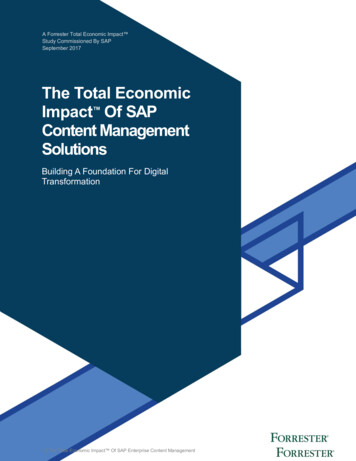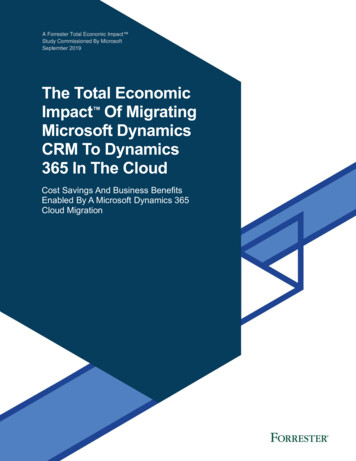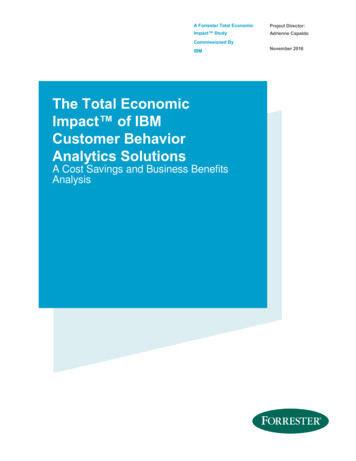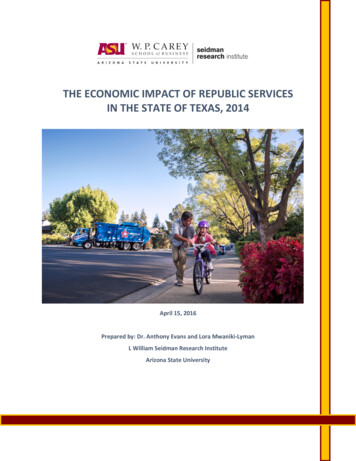
Transcription
A Forrester Total Economic Impact StudyCommissioned By MicrosoftSeptember 2018The Total EconomicImpact Of MicrosoftDynamics 365 ForFinance And OperationsCost Savings And Business Benefits EnabledBy Dynamics 365 For Finance And Operations
Table Of ContentsExecutive SummaryKey Findings11TEI Framework And Methodology3Customer JourneyInterviewed OrganizationsKey Challenges6Solution Requirements7Key Results8Composite OrganizationAnalysis Of BenefitsOperations Efficiency101111Employee Productivity13Wholesale Profit17Retail Profit18Legacy Cost Avoidance21Unquantified Benefits23Flexibility27Analysis Of CostsImplementation2929Licensing32Support And Management33Financial SummaryMicrosoft Dynamics 365 for Finance and Operations: OverviewAppendix A: Total Economic ImpactProject Director:Benjamin Brown44353638ABOUT FORRESTER CONSULTINGForrester Consulting provides independent and objective research-basedconsulting to help leaders succeed in their organizations. Ranging in scope from ashort strategy session to custom projects, Forrester’s Consulting services connectyou directly with research analysts who apply expert insight to your specificbusiness challenges. For more information, visit forrester.com/consulting. 2018, Forrester Research, Inc. All rights reserved. Unauthorized reproductionis strictly prohibited. Information is based on best available resources.Opinions reflect judgment at the time and are subject to change. Forrester ,Technographics , Forrester Wave, RoleView, TechRadar, and Total EconomicImpact are trademarks of Forrester Research, Inc. All other trademarks are theproperty of their respective companies. For additional information, go toforrester.com.
Executive SummaryKey BenefitsImproved operationsefficiency: 39 millionIncreased employeeproductivity: 20.6 millionMicrosoft Dynamics 365 for Finance and Operations is an enterpriseresource planning (ERP) solution delivered as a service from the cloudthat customers use to operate the core of their businesses. Microsoftcommissioned Forrester Consulting to conduct a Total Economic Impact (TEI) study and examine the potential return on investment (ROI)enterprises may realize by deploying Microsoft Dynamics 365 for Financeand Operations. The purpose of this study is to provide readers with aframework to evaluate the potential financial impact of Microsoft Dynamics365 for Finance and Operations on their organizations.To better understand the benefits, costs, and risks associated with thisinvestment, Forrester interviewed seven customers with years ofexperience using Microsoft Dynamics 365 for Finance and Operations.Each customer’s use case varied, but all adopted Dynamics 365 to replaceaging, siloed ERP systems that offered bad user experiences. For manyinterviewees, a new ERP was not a choice — their legacy systems werefailing to meet capability and performance needs as their businesses grew.All seven organizations desired a cloud ERP with top tier capabilities thatcould be rolled out in modules to accelerate deployment and avoidpotential disruption. By moving to the cloud and staying up-to-date,organizations also sought to permanently reduce the cost and pain ofsystems administration.Ultimately, the seven interviewed organizations indicated key benefits ofenhanced data, business insights, operations efficiency, and productivityimprovements among many others. Interviewees indicated that withMicrosoft Dynamics 365 for Finance and Operations, they had undergonekey business transformation that they hoped would drive growth andmarket leadership for many years to come.Key FindingsForrester synthesized a composite organization and created a financialmodel that is representative of the seven interviewed customers.Increased wholesaleand retail profit: 4.6 millionQuantified benefits. The following three-year risk-adjusted present value(PV) benefits for the composite organization are based on thoseexperienced by the seven interviewed customers:› Operations efficiency savings of 39 million. Real-time data analysis,automation, and streamlined processes enhance forecasts, improvequality, reduce waste, and prevent delays — reducing cost of goods soldby 10% and improving gross margin by 2.4 percentage points.› Employee productivity savings of 20.6 million. Automation, betteruser experience, reduced rework, and enhanced forecasting increasedproductivity companywide. The composite organization reduces shopfloor staffing by 6%, increases finance productivity by 20%, andincreases sales representative productivity by 4%.› Increased wholesale profit of 3.3 million. Better quality, reduceddelays, improved ordering and invoicing combined with increased salesproductivity avoids lost revenue, increases customer retention, anddrives additional sales to increase wholesale revenue by 3%.› Increased retail profit of 1.3 million. Improved tracking and salesforecasting enables organizations to optimize inventory in stores,preventing lost sales from out-of-stock products, reducing inventory1 The Total Economic Impact Of Microsoft Dynamics 365 For Finance And Operations
shrinkage, and avoiding discounting — ultimately increasing revenue by4% and decreasing excess inventory and shrinkage by 10%.ROI60%› Legacy cost avoidance of 10.6 million. Organizations avoided legacylicense, maintenance, hardware, and systems administration costs byadopting Microsoft Dynamics 365 for Finance and Operations.Benefits PV 74.9 millionNPV 28.1 millionUnquantified benefits. The interviewed organizations experienced thefollowing benefits, which are not quantified for this study:› Cloud simplicity with enhanced system performance.› Improved user experience with more pleasant user interface and greaterflexibility to access systems anytime, anywhere.› Gained agility to quickly deploy and integrate new lines of business,reducing labor costs and accelerating time-to-market.› Enhanced security, governance, and fraud prevention.› Attained the ability to build applications that leverage core ERP datawithout risk of breaking ERP functionality.Costs. The following are the composite organization’s three-year riskadjusted present value costs based on the seven interviewed customers:Payback20 months› Implementation costs of 27.8 million. The composite organizationconducts a two-phase rollout of 12 months per phase, with accumulatedimplementation costs from internal labor, third-party professionalservices, and hardware modernization.› Licensing costs of 9.1 million. The organization incurs monthlylicensing fees for 1,400 users, 1,000 devices, and 120 retail stores.› Support and management costs of 9.9 million. The compositeorganization incurs ongoing costs of IT administrators, trainers, thirdparty update services, and third-party support escalation.Forrester’s interviews with seven existing customers and subsequentfinancial analysis found that an organization based on these interviewedorganizations experienced benefits of 74.9 million over three yearsversus costs of 46.8 million, adding up to a net present value (NPV) of 28.1 million and an ROI of 60%.Benefits (Three-Year)Financial Summary 39.0MTotalbenefitsPV, 74.9MPayback:20 months 20.6M 10.6MTotalcosts PV, 46.8MInitialYear 1Year 2Year 3 3.3M 1.3MOperations Employee Wholesale Retail profit Legacy costefficiency productivityprofitavoidance2 The Total Economic Impact Of Microsoft Dynamics 365 For Finance And Operations
TEI Framework And MethodologyFrom the information provided in the interviews, Forrester has constructeda Total Economic Impact (TEI) framework for those organizationsconsidering implementing Microsoft Dynamics 365 for Finance andOperations.The objective of the framework is to identify the cost, benefit, flexibility, andrisk factors that affect the investment decision. Forrester took a multistepapproach to evaluate the impact that Microsoft Dynamics 365 for Financeand Operations can have on an organization:The TEI methodologyhelps companiesdemonstrate, justify,and realize thetangible value of ITinitiatives to bothsenior managementand other keybusinessstakeholders.DUE DILIGENCEInterviewed Microsoft stakeholders and Forrester analysts to gather datarelative to Microsoft Dynamics 365 for Finance and Operations.CUSTOMER INTERVIEWSInterviewed seven organizations using Microsoft Dynamics 365 forFinance and Operations to obtain data with respect to costs, benefits, andrisks.COMPOSITE ORGANIZATIONDesigned a composite organization based on characteristics of theinterviewed organizations.FINANCIAL MODEL FRAMEWORKConstructed a financial model representative of the interviews using theTEI methodology and risk-adjusted the financial model based on issuesand concerns of the interviewed organizations.CASE STUDYEmployed four fundamental elements of TEI in modeling the impact ofMicrosoft Dynamics 365 for Finance and Operations: benefits, costs,flexibility, and risks. Given the increasing sophistication that enterpriseshave regarding ROI analyses related to IT investments, Forrester’s TEImethodology serves to provide a complete picture of the total economicimpact of purchase decisions. Please see Appendix A for additionalinformation on the TEI methodology.DISCLOSURESReaders should be aware of the following:This study is commissioned by Microsoft and delivered by Forrester Consulting.It is not meant to be used as a competitive analysis.Forrester makes no assumptions as to the potential ROI that otherorganizations will receive. Forrester strongly advises that readers use their ownestimates within the framework provided in the report to determine theappropriateness of an investment in Microsoft Dynamics 365 for Finance andOperations.Microsoft reviewed and provided feedback to Forrester, but Forrester maintainseditorial control over the study and its findings and does not accept changes tothe study that contradict Forrester’s findings or obscure the meaning of thestudy.Microsoft provided the customer names for the interviews but did not participatein the interviews.3 The Total Economic Impact Of Microsoft Dynamics 365 For Finance And Operations
Customer JourneyBEFORE AND AFTER THE MICROSOFT DYNAMICS 365 FOR FINANCE ANDOPERATIONS INVESTMENTInterviewed OrganizationsFor this study, Forrester conducted seven interviews with MicrosoftDynamics 365 for Finance and Operations customers. Interviewedcustomers include the following:INDUSTRYREGIONSIZEUSE CASESINTERVIEWEESEnergyinfrastructureGlobal 500M – 1B revenueLess than 500 FTEsFinanceOperationsManager of business applicationsEntertainmentagencyGlobal 100M – 500M revenue1,000 – 5,000 FTEsFinanceERP ManagerSpecialty foodsmanufacturingand retailNorthAmerica 100M – 500M revenue1,000 – 5,000 FTEs500 seasonal retail storesFinanceManufacturingOperationsRetailChief operating officerGeneral retailNorthAmerica 100M – 500M revenue1,000 – 5,000 FTEs100 retail storesFinanceRetailVP of information technologyDirector of IT and operationsApparel brandGlobal 100M – 500M revenueLess than 500 FTEsFinanceOperationsRetailDirector of ITEPC contractingGlobal 50M – 100M revenueLess than 500 FTEsFinanceManufacturingOperationsSystems engineerAutomotivemanufacturingNorthAmerica 10M – 50M revenueLess than 500 FTEsFinanceManufacturingOperationsERP ManagerInterviewed customers started from varying legacy environments anddeployed Microsoft Dynamics 365 for Finance and Operations for avariety of use cases. Deployments include:› Global energy infrastructure company with less than 500employees and 500 million to 1 billion in annual revenue. Thecompany sought a Tier 1 ERP to replace its existing 15-year-old onpremises solution to enable business transformation with enhancedcapabilities, cloud flexibility and savings, and future reductions intechnical debt by staying up-to-date with regular releases. Deploymentwas in two phases with a 12-month implementation of core finance,supply chain, intelligence, development, and administration modulesfollowed by a nine-month phase for “nice-to-have” enhancements. Thecompany has expanded into Power BI, Power Apps, Flow, and islooking into leveraging AI in the future.› Global entertainment agency with between 1,000 and 5,000employees and 100 to 300 million in annual revenue. Theagency adopted Microsoft Dynamics 365 for Finance and Operationsas part of corporate cloud initiative, seeing flexibility to the business4 The Total Economic Impact Of Microsoft Dynamics 365 For Finance And Operations
and users combined with low total cost of ownership (TCO) as keydifferentiators for being in the cloud. Implementation of finance andaccounting capabilities took nine months, and the agency foundintegrating acquisitions and establishing subsidiaries in other countrieswas substantially easier with the cloud deployment of Dynamics.› North American specialty foods manufacturer and retailer thatemploys up to 5,000 employees seasonally and generates 100 to 500 million in annual revenue. The company’s business is highlyseasonal, quickly opening and closing over 600 retail sites in a threemonth period every year. The company adopted Microsoft’s completeslate of ERP capabilities for three primary reasons: 1) to keep pacewith its aggressive organic growth strategy; 2) to consolidate fourexisting, loosely integrated solutions; and 3) to reduce the expertiserequired for customization and management of a cloud solution.Deployment was conducted in three phases with finance and supplychain components followed by a direct-to-consumer integration andpilot retail program, and finally a full retail store deployment that isslated to occur during the next seasonal rollout.› North American general retailer with 1,000 to 5,000 employees,100 retail stores, and 100 to 500 million in annual revenue. Theretailer’s former on-premises ERP and retail solution was end-of-lifeand could not meet their business growth and modern needs. Thesolution began having data syncing and inventory issues since theretailer surpassed 60 stores, and licenses were no longer evenavailable. The retailer sought a “full-blown” ERP solution; MicrosoftDynamics 365 for Finance and Operations offered the desired top-tiercapabilities, and as its VP of IT noted, the solution “was significantlyless expensive” than other offerings they scoped. Implementation ofthe core ERP took 12 months followed by a seven-month rollout toretail stores.“Our previous system workeduntil we reached about 60stores, and then we hadissues with data syncing andinventory transfers. We had toturn certain things off to getother elements to work, and itwas pretty much a full-time jobto support.”Vice president of informationtechnology, general retail› Global apparel brand with online retail and B2B sales distributionthat employs under 500 employees and earns 100 to 500 millionin annual revenue. The brand’s existing ERP solution could not scaleto meet the growing needs of the business and lacked key capabilities,and it invested in Dynamics 365 for Finance and Operations hoping todeliver capabilities throughout the supply chain with minimalcustomizations. Implementation took 18 months.› Global, North American-based engineering, procurement, andconstruction (EPC) contractor with fewer than 500 employees and 50 to 100 million in annual revenue. The company adoptedDynamics 365 for Finance, Manufacturing, and Operations to alleviateon-premises hardware and personnel costs and gain business insightsregarding sales, production, and shipping to increase profitability.Implementation took only three months and the environment is fullymaintained by Microsoft.› North American, fast-growing automotive manufacturer withrevenue doubling annually to a present state of 50 to 100million. The manufacturer was highly reliant on a paper processes,locally maintained spreadsheets, and a basic bookkeeping solutionthat also has a rapidly degrading database. To protect its business andkeep pace with the massive growth, the company needed a modern,easy-to-use, and scalable ERP system. The manufacturer conducted arapid deployment process in six months to go live and is currentlyusing Microsoft’s manufacturing, warehouse management, inventory,finance, and sales capabilities.5 The Total Economic Impact Of Microsoft Dynamics 365 For Finance And Operations“Our legacy finance system ranoff a single file, and that filewas becoming unstable. Wedid not have a choice, and weneeded to move quickly —Dynamics 365 fit the bill, andwe went from start to finish inonly six months.”ERP manager, automotivemanufacturing
Key ChallengesInterviewed organizations identified several key challenges of theirlegacy ERP environments that led to the investment in MicrosoftDynamics 365 for Finance and Operations:› Legacy systems inhibited growth. Several interviewed organizationswere using decades-old ERP solutions, while others had undergonemajor business growth but still used basic products as remnants ofearly years. For both categories of organizations, the ERP systemsfailed to keep pace with their growing needs and the organizations hadaccumulated significant amounts of technical debt. Therefore, the ERPsolutions had become a hindrance with inadequate performance, pooruser experience, a lacking functionality, and excessive customizations.Solutions were reaching end-of-life and had becomeforeign to IT departments. “We had a 25-year-old core ERPsystem that was out of support and that virtually nobody in thecompany understood,” explained the chief operating officer ofa specialty foods brand. The director of IT and operations foranother retail organization described how, “[We] can’t evenbuy licenses of [our previous solution] anymore.” The energyinfrastructure manager of business applications concurred:“After 15 years with our previous on-premise solution, we weremerely keeping the lights on. We were no longer investing inkeeping the system up to date, and consequently, the systemwas not effectively supporting the rate of change and growththat our business was experiencing.”Legacy solutions were failing as companies grew.Companies had to dedicate significant labor just keepinglegacy solutions functional, instead of working to grow thebusiness. Younger companies were especially challenged asgrowth brought them head to head with enterprises. Simplebookkeeping was not enough, “Everything was running out ofspreadsheets,” remarked the ERP manager for the automotivemanufacturing company. They continued, “Revenues weredoubling year-over-year, and we could not stay in ourenvironment and expect to scale with the volume oftransactions, data, and accounting. Our organization is youngand growing so much — accelerated growth createschallenges the existing system could not handle. Master dataand business values, inventory, BOMs, etc, were low inaccuracy. We didn’t have the rails around us in ourenvironment to keep things clean and that was painful.”Performance issues plagued users. Users were hamperedby system performance and cumbersome and unintuitive dataentry. The systems engineer for the EPC contracting firmnoted that the power users within the organization spentsignificant amounts of their time answering a common set ofquestions, which took time away from the main duties andmeant that less data was being entered into the ERP systemand further that they had less time to analyze the data.› Organizations were blind to business insights due to siloed andinadequate data. Systems were siloed between sites and functions,and organizations lacked a central way to track and analyze data.Reports had to be painstakingly constructed, even for just a one-timeanalysis. Worse, with paper processes and employees sidestepping6 The Total Economic Impact Of Microsoft Dynamics 365 For Finance And Operations“We had a 25-year-old coreERP system that was out ofsupport and that virtuallynobody in the companyunderstood.”Chief operating officer, specialtyfoods manufacturing and retail“After 15 years with ourprevious on-premises solution,we were merely ke
organizations will receive. Forrester strongly advises that readers use their own estimates within the framework provided in the report to determine the appropriateness of an investment in Microsoft Dynamics 365 for Finance and Operations. Microsoft reviewed and provided feedback to For











